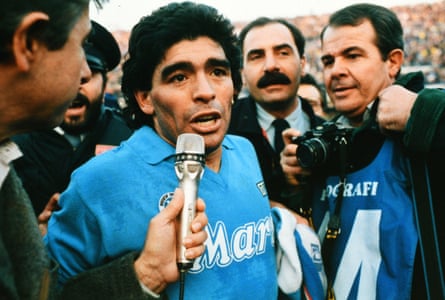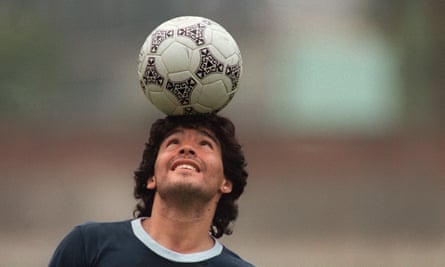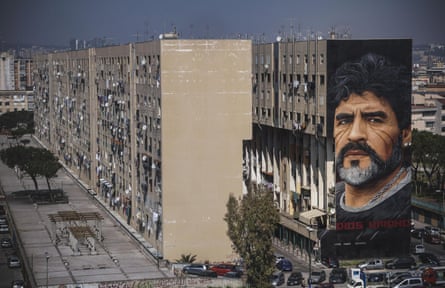“Thank you to my sources of inspiration: Federico Fellini, Talking Heads, Martin Scorsese and Diego Armando Maradona,” professed director Paolo Sorrentino on stage at the 86th Academy Awards. It’s not often a footballer features in an Oscar acceptance speech. Sorrentino had just won the best foreign language film award for his masterpiece La Grande Bellezza and, hailing from Naples, the acclaimed filmmaker understood better than most what Maradona gave to the city.
Perhaps no player in the history of the game is as embedded into the fabric of a city as Maradona is in Naples. His image is everywhere. Negotiate your way through the narrow Spaccanapoli region of the city and you will see Neapolitans selling just about anything that can adorn Maradona’s face. Make your way to the similarly claustrophobic Quartieri Spagnoli district, walk up the steep, cobbled streets that bustle with everyday life, and gaze at his wall-size mural. Order a Neapolitan-style caffè in Bar Nilo on the corner of Via San Biagio, dedicated solely to Maradona, and observe your surroundings, complete with a single strand of Maradona mane, stolen from his headrest while he was on a flight back to Naples from Turin, and vials supposedly filled with tears of locals who cried upon his acrimonious departure from Italy in March 1991.
For a time, it was the perfect match: Maradona needed a home and Naples needed a saviour. San Gennaro is the city’s patron saint, but Maradona has obtained deity status. From 1984 to 1991, 515 children were registered as having the name Diego, with 12 receiving the full Diego Armando treatment. “We have a lack of houses, schools, buses, employment and sanitation, but none of this matters because we have Maradona,” declared a local newspaper. To celebrate Maradona’s 60th birthday, here are six of his finest goals for the Partenopei.

6. Lazio v Napoli, October 1984
Three months had passed since Maradona emerged from the bowels of the Stadio San Paolo greeted by 80,000 trophy-starved Neapolitans on a humid July day. Despite being the world’s best player, Maradona faced an immediate uphill battle. The Napoli of 1984-85 was a middling outfit who had finished 10th and 11th in their previous two campaigns. A young Ciro Ferrara and future Derby County cult hero Ciccio Baiano were among the ranks, in addition to stalwarts such as defender Guiseppe Bruscolotti and goalkeeper Luciano Castellini. According to Maradona, they were a ‘“Serie B team”.
Maradona had already scored twice in Serie A for his new club – a penalty against Sampdoria and a neat run and finish against Como – as they headed into the fifth game of the season against Lazio at the Stadio Olimpico.
Lazio, containing a young Michael Laudrup, had taken the lead before the break. Six minutes into the second half, Maradona equalised. Stood on the periphery of the penalty area alongside compatriot Daniel Bertoni and three Lazio defenders, Maradona produced a remarkably intricate give-and-go with Bertoni that took two defenders out of the equation. Maradona ran into the path of Bertoni’s lofted return pass and controlled the ball with his chest before effortlessly volleying it into the opposite corner. It was Italy’s first glimpse of Maradona’s genius. There was plenty more to follow.
Maradona wasn’t finished tormenting Lazio that season. He scored a hat-trick in the return match, including this marvel and this cheeky effort straight from a corner. Lazio were relegated at the end of the season. At least they wouldn’t have to face Maradona for a further three years.

5. Napoli v Milan, November 1988
Maradona seemed to save his best goals for Milan. In fact, the Rossoneri are tied with Sampdoria as the two teams Maradona scored against most during his time in Italy. This list could easily have just contained his goals against Milan (I present exhibits A, B, C and D, your honour). They brought out the best in him.
Milan emerged as Napoli’s biggest rivals for the Scudetto in the second half of the 1980s as Juve faded away in the aftermath of Michel Platini’s retirement. Bar a brief interlude, when Giovanni Trapattoni led Inter to the title in 1988-89, Milan and Napoli were the two best teams in Serie A and regularly traded blows at the top of the table. Matches between the pair were box office: Marco Van Basten, Ruud Gullit and Frank Rijkaard against Maradona, Careca and Alemao.
Arrigo Sacchi’s side pipped Napoli to the league title in the 1987-88 season. Crucially they did the double over Napoli, winning the two fixtures by an aggregate scoreline of 7-3 (a cricket score in the binary world of 1980s Serie A). The second match, which Milan won at the San Paolo in May, has remained clouded in controversy, with rumours swirling for years that a number of Napoli players essentially downed tools towards the end of the campaign due to interference from the Camorra. After suffering just two defeats in 25 games they lost four of their last five matches to cede the title to Milan.
Fast-forward six months to November 1988 and Maradona had revenge on his mind. Having slaughtered Juventus 5-3 in Turin the previous week, Napoli motored through Milan as well, winning 4-1. Maradona led the charge, of course, scoring the opener with a header from 25 yards out. The goal does not have the same aesthetic appeal as some of his other strikes against Milan, but it does highlight two things: Maradona’s astonishing ingenuity and the revolutionary high line that Sacchi instilled at Milan, hitherto unseen in Italian football.
“He used to score against us often,” Franco Baresi told FourFourTwo magazine in 2009. “We had to be very well organised: put pressure on him, doubling up, tripling up even to limit his talents. Because if it was one-on-one, you’d lose. When he was on form, there was almost no way of stopping him.”
4. Bologna v Napoli, April 1990
Maradona’s final moment of greatness for Napoli. As the 1988-89 season was drawing to a close, Maradona believed he had nothing left to prove at Napoli. They had won an historic double in 1986-87 and he had just guided them to the Uefa Cup final. Maradona had agreed personal terms with Bernard Tapie to join his Marseille revolution.
Maradona believed a move away from the intense pressure of playing in Serie A was best for his state of mind. He wanted more tranquil surroundings than the loving but suffocating environment of Naples (although how he imagined a move to Marseille being less intense is up for debate, given the similarities between the cities). According to Maradona, club president Corrado Ferlaino agreed that should Napoli win the Uefa Cup, he would not stand in his way.
Maradona duly obliged, with Napoli beating Stuttgart 5-3 in the two-legged final. However, the dream of leaving on the highest of notes was shattered by Ferlaino, who called off the deal as soon as the trophy was lifted in Stuttgart. “I wanted to smash the cup over his head,” wrote Maradona in his 2000 autobiography, El Diego.
Much like Josep Maria Bartomeu at Barcelona this summer, Ferlaino did not want to go down in history as the president who sold Maradona. He knew that letting Maradona leave would led to chaos in the city and, probably, Ferlaino having to flee as well.
Maradona felt betrayed. “I was pissed off,” he said in Asif Kapadia’s absorbing documentary last year. Looking for any form of escapism, Maradona buried himself in cocaine, alcohol and hedonistic debauchery. He would play for Napoli every Sunday afternoon and then go on a drink- and drug-fuelled binge until Wednesday, at which point he would sweat the toxins out for the rest of the week. Rinse and repeat throughout the 1989-90 season.
The lithe frame of the early Napoli years had given way to a more rotund figure, but Maradona’s body could still comply with his brain’s demands, just. Against Bologna at the Stadio Renato Dall’Ara on the penultimate day of the season, Napoli raced into a third-minute lead thanks to the vastly underrated Careca. Six minutes later, Maradona made it two.
Running on to a throw-in from Massimo Crippa, Maradona cuts in from the right-hand side and carries the ball along the outer edges of the area, evading two challenges before beautifully arcing a long-range shot into the bottom corner of Nello Cusin’s goal. Maradona would later slip through a pass for midfielder Alemao to put the seal on a 4-2 win.
It speaks to Maradona’s talent and the extraordinary force of his personality that he could operate at the highest sporting level in spite of his self-sabotage. He not only produced his best season in Serie A, scoring 16 goals, but also drove Napoli to win their second league title, finishing above Sacchi’s Milan by two points. They have not won Serie A since.
The lamentable tragedy of Maradona is the self-recognition that he could have achieved so much more: “Do you know what a player I’d have been if I hadn’t taken cocaine?” he says in Emir Kusturica’s 2008 documentary Maradona by Kusturica. “What a player we lost,” he adds, hands clasped together in that classic Maradona way.

3. Napoli v Verona, October 1985
Maradona knew little of Naples and the prevailing attitude from the north of Italy when he joined in 1984. “Napoli meant no more than something Italian, like pizza,” he would later say. But Maradona quickly found out about the north-south divide on his debut against Verona at the Stadio Bentegodi that September.
“We went up north and, wherever we went, they put up banners that said: ‘Wash yourselves.’ It was disgusting. They were all racists,” said Maradona. But, much like Michael Jordan in The Last Dance, Maradona was at his best when fuelled by anger, fury or resentment towards something or someone, imaginary or otherwise. There was always a beast to slay. The greater the adversity, the better he performed.
The Verona ultras introduced Maradona to his first sights of “Welcome to Italy” and “lavatevi (wash yourself)” banners, and he never forgot it. Verona had miraculously won the Scudetto in Maradona’s first season in Italy and they rolled into Naples the following October as the defending champions.
Maradona tore them to shreds in a comprehensive 5-0 win, dictating the game and scoring Napoli’s third goal. The beauty of the goal is in Maradona’s technique, the effortless way in which he first controls the high ball, spins, sees goalkeeper Giuliano Giuliani off his line and adds just enough power, and spin, on the ball to leave Giuliani with little chance of making a save as it arrows in via the post. It was so good he even received a handshake from Verona’s midfielder Luciano Bruni as he ran back to the centre-circle.

2. Napoli v Juventus, November 1985
Two games after the 5-0 mauling of Verona, Juventus ventured south to the Stadio San Paolo. Spend a day in Naples and you quickly learn there is no side more despised by Neapolitans than Juve. To them, the Old Lady symbolise the cold, northern establishment that always wins. “I felt as though I represented a part of Italy that counted for nothing,” said Maradona. He thrived off being the poster boy for the impoverished south, the street urchin taking on the prosperous north. David versus Goliath; north against south; Maradona against everyone. That was how he liked it.
In the early years, Juve were still the dominant force in Italian football, with Platini at his best. Games between the teams often came down to Platini v Maradona, French elegance v Argentinian wizardry. In six meetings with Maradona, Platini only came out on top once before he retired at the end of the 1986-87 season.
When they met on a rain-drenched pitch in November 1985, Maradona was on top form, gliding past opposing players and giving the illusion that he had the ball on a leash. When Napoli were awarded a bizarre indirect free-kick, Maradona had little room in which to manoeuvre. He delicately caressed the ball over the wall and high into Stefano Tacconi’s goal, sending the crowd into such frenzied delirium that five Neapolitans fainted and two others suffered heart attacks inside the ground. It was Napoli’s first league win against Juve for 12 years, and they would go on to regularly humiliate their more illustrious rivals over the second half of the decade. Much to the joy of Maradona, of course.

1. Brescia v Napoli, September 1986
What Maradona achieved in Naples is comic book material: the world’s finest player arrives at down-at-heel club, with no history of success, and propels said club to unfathomable triumphs in the most challenging league in the sport.
Only Cagliari, thanks to the volcanic left foot of Gigi Riva, had ever taken the Scudetto south of Rome. Since his arrival, Maradona had steadily built Napoli into a respectable force: “We built Napoli from the bottom, it was proper workmanship,” he wrote. An eighth-placed finish in his first season followed third in the second. Momentum was building.
On the opening day of the 1986-87 season, Napoli travelled north to face Brescia and Maradona, 10 weeks after lifting the World Cup in Mexico, meant business. A drab encounter sprang into life five minutes before the interval when midfielder Bagni lofted a high ball in the direction of Maradona, who was surrounded by Brescia shirts outside the box with his back to goal.
He controls the ball instantly with his chest, letting it drop to the floor. As soon as the ball hits the turf, he’s off, accelerating at rapid pace, gliding past players with such beguiling fluidity. Maradona, now in full flight, arrows a shot into the opposite corner of Roberto Aliboni’s goal, leaving the keeper with little to do other than pick the ball out of the net. The entire sequence takes four mesmerising seconds.
“Football is a game of deceit,” Maradona explained in Kapadia’s documentary. “You feint going over there, then go in the opposite direction and your opponent goes the other way.” Is there a better goal in Maradona’s catalogue – certainly at club level - that better illustrates his point?
Napoli would remain unbeaten until January and won their first Scudetto on 10 May. The city of Naples partied like it was 1999, with mock funerals held for the northern powerhouses. The celebrations carried on for two months. A banner that said, “You don’t know what you’ve missed!” was hung outside a Neapolitan cemetery.
“The victory marked the social redemption of our city,” observed Ciro Ferrara. “Thanks to Diego, it continued in the following years.” For a brief moment in time, the balance of power in Italy had swung southwards. That was Maradona’s greatest achievement in club football. “Now the doubters had to believe that I was the best,” he said. “I was alone there, above everyone else.” The greatest player of all time? Arguably. The most innately gifted? Indisputably.

Comments (…)
Sign in or create your Guardian account to join the discussion